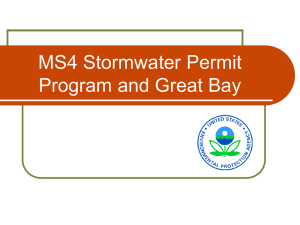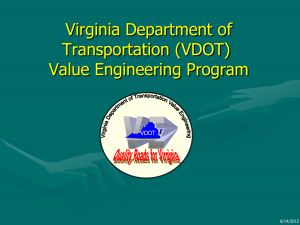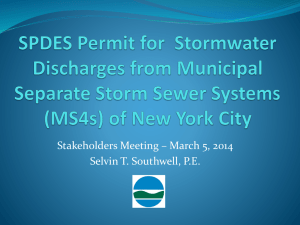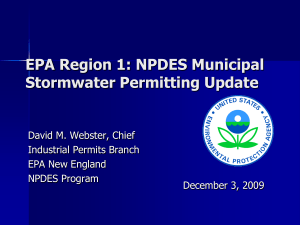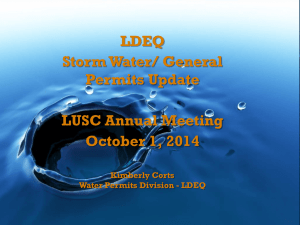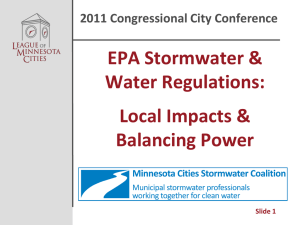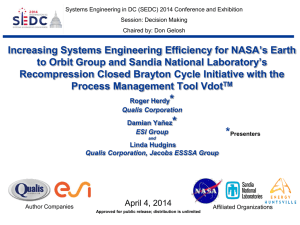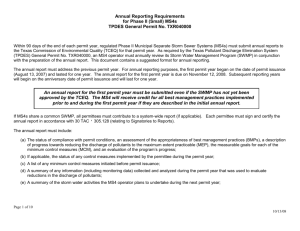VDOT`s ASCE SW Program Presentation 2-20-14
advertisement
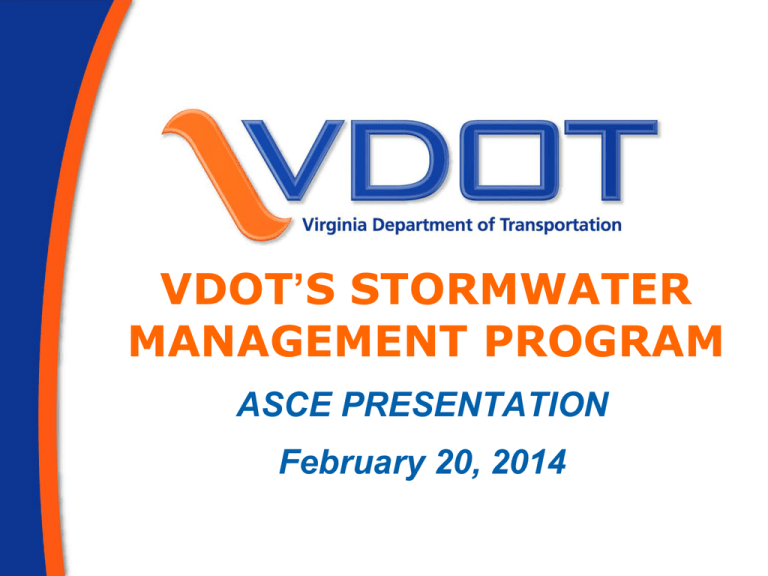
VDOT’S STORMWATER MANAGEMENT PROGRAM ASCE PRESENTATION February 20, 2014 PRESENTATION OUTLINE VDOT SWM Program Overview/Challenges Roy Mills – L&D Division Stormwater Management Regulations in Virginia and VSMP Part IIB Technical Criteria Ginny Snead, P.E. – Maintenance Division (Louis Berger contract employee) TMDL (Total Maximum Daily Load) Program Tracey Harmon – Environmental Division 2 VDOT’S STORMWATER MANAGEMENT PROGRAM AREAS Erosion and Sediment Control o Construction site controls Post Construction Stormwater Management o Water quality/quantity BMPs VSMP Construction Permit o Coverage for regulated land disturbing activities MS4 Permit o Covers VDOT operations in the 15 Census Urban Areas of the State 3 PROGRAM ADMINISTRATION VDOT CENTRAL OFFICE Manages statewide program Develops policies and guidance VDOT DISTRICT/RESIDENCY OFFICES Implements policies and procedures OFFICE OF THE STATE SWM PROGRAM ADMINISTRATOR (CO L&D) 4 Develops policies/guidance Provides/coordinates training Manages budget & consultant contract Submits to DEQ for VSMP Construction Permit coverage for land disturbing activities Develops MS4 Implementation Plan PROGRAM ADMINISTRATION (Cont.) 2 Staff Engineers MS4 Steering Committee 5 L&D Division Environmental Division Maintenance Division Traffic Engineering Division Transportation Planning Division Learning Center Construction Division Communications Office District Construction Representative District Maintenance Representative VCTIR Representative MS4 Consultant PROGRAM ADMINISTRATION (Cont.) SWM Program Policy Committee 6 Deputy Chief Engineer Construction Division Administrator Maintenance Division Administrator Environmental Division Administrator Learning Center Administrator District Administrator Representative ADDITIONAL PROGRAM DETAILS BUDGET $3.5 Million Annually Does not include: • Project related cost • Cost covered by normal operationally expenses • Cost for any retrofit BMPs MS4 CONSULTANT CONTRACT 3 Term Contract (Began April 2014) $3 Million maximum per term EEE Consulting (Prime) Stantec (formerly WEG) and JMT (Subs) 7 CHALLENGES or OPPORTUNITIES THAT ARE CLEVERLY DISGUISED 8 VSMP CONSTRUCTION PERMIT 9 Existing permit expires 6/30/14 New Permit begins 7/1/14 New permit approved by SWCB 12/13 New permit includes new/revised requirements for: Construction inspection frequency SWPPP/SWM inspections P2 Plans (Pollution Prevention) P2 training for contractor personnel Requirements to meet EPA’s Effluent Limitation Guidelines (ELGs) Projects with coverage under current permit must reapply for coverage under new permit by June 1 and SWPPPs must be updated within 60 days of new permit coverage to incorporate any new or revised requirements (includes projects under construction) MS4 PERMIT New Phase II General Permit effective 7/1/13 VDOT received coverage under the new permit on 11/1/13 Permit contains new requirements for the six Minimum Control Measures (MCMs): o Public Education and Outreach Identify 3 high priority water quality issues, develop an appropriate message and delivery to a target audience o Public Involvement/Participation Participate in 4 local SWM activities annually 10 MS4 PERMIT (Cont.) o Illicit Discharge Detection and Elimination (IDDE) Complete the storm sewer system outfall map and information tables and make info available upon request Complete and implement IDDE procedures Provide for public reporting of potential illicit discharge o Construction Site Stormwater Runoff Control New inspection requirements P2 Plans and contractor training 11 MS4 PERMIT (Cont.) o Post Construction Stormwater Management New water quality and quantity requirements and compliance methods (Runoff Reduction and Energy Balance Equation) New BMP selection list (BMP Clearing House Website) o Pollution Prevention/Good Housekeeping for Municipal Operations SWPPPs for high priority facilities P2 Plans for onsite operations Biennial training for employees 12 MS4 Permit (Cont.) Contains Special Conditions for addressing : o Chesapeake Bay TMDL Requires determination of pollutant loads and required reductions on developed lands prior to 2009 Requires achieving 5% of total load reductions prior to end of current permit cycle (6/30/18) o Other TMDLs (Local) 8 from previous permit – Continue implementation of Action Plans 14+/- new ones – Develop Action Plans 13 OTHER ITEMS OF INTEREST DEQ’S SWM CERTIFICATION PROGRAM Similar to ESC Certification Program except no exemption for a professional license (P.E./L.A./L.S.) for initial Plan Reviewer certification SWM Inspector & Plan Reviewer Certifications required by 7/1/14 for appropriate personnel DEQ currently conducting 2 day Basic and 1 day Inspector classes 2 day Plan Reviewer Classes due in early Spring 2014 VDOT has received approval to conduct the training classes for its internal employees and consultant contract personnel (training is currently underway for 600+ people) 14 OTHER ITEMS OF INTEREST (Cont.) SUPPORT FACILITIES – VSMP CONSTRUCTION PERMIT COVERAGE Supplemental Specification (SS) finalized and was available for inclusion in construction contracts beginning 9/13 Contractor develops plans & VDOT obtains permit coverage for all facilities located within VDOT right of way or easement. Contractor develops plans and obtains permit coverage for all facilities located outside VDOT right of way or easement 15 OTHER ITEMS OF INTEREST (Cont.) CURRENT RESEARCH ACTIVITIES (VCTIR) Lorton Road Project LID BMP Evaluations Maintenance Requirements for Permeable Asphalt Pavement – Route 66/234 Park and Ride Lot Use of Nutrient Credit Banks to satisfy water quality requirements for VDOT projects BMP Design Manual of Practice – Phase II STANDARDS and SPECIFICATIONS Revised EC-5 Silt Fence Standards New Standard Sheets for Clearing House BMPs – Construction Details, Specifications and Inspection Protocols (for construction and post construction) 16 FIRST INTERMISSION 17 STORMWATER REGULATIONS IN VIRGINIA AND NEW VSMP TECHNICAL CRITERIA (PART IIB) 18 STORMWATER REGS IN VA Clean Water Act/NPDES Industrial SW GP Construction SW GP MS4: Phase I Ind., Phase II GP State Regulatory Programs Va SW Management Permit Statewide Erosion and Sediment Control Statewide Chesapeake Bay Preservation Tidewater 2014 VSMP Regulation Changes New Construction GP Water Quality Criteria Water Quantity Criteria Local Programs Stormwater Criteria Address Land Use Changes as a Result of Development Pre-development – non-regulated land use Land Disturbance Activity regulated under federal regulation Post-development – non-regulated land use The water quality and quantity design criteria are implemented in conjunction with the VSMP General Permit for Stormwater Discharges from Construction Activities. These criteria are based on a State regulation separate from federal requirements. Water Quality: Key Differences Existing Rules Modified Rules Impervious Surface (IC) only Land Use(s) IC + Forest/Open Space + Managed Turf 0.5 inches of Runoff from the IC only Event 1.0 inches of Rainfall from the whole site Average land condition/ technology based 10% reduction TP New Design Criteria Redevelopment Criteria Simple Method Compliance Methodology 0.41 lbs./ac/yr TP <1 acre = 10% red. TP, >1 acre = 20% red. TP Runoff Reduction Method (RRM) Current Methodology “Traditional” BMP pollutant removal efficiencies do not take into account the removal that occurs when the runoff volume is reduced. Many BMPs do not reduce runoff volume at all. Runoff Reduction Method Using BMPs that also provide volume reduction provides greater overall pollutant (mass load) removal This reflects a “Mass Balance” Approach New Design Criteria Environmental Site Design There is no longer a specified “Average land cover condition” (% Imp. Cover or Poll. Load) below which you are not required to meet any water quality requirements Imagine the site as an area “Site” is redefined that you can put construction fencing around ,but including undisturbed areas that are going to be protected as part of the plan. Stormwater Offsets Program Current Program to Offset Phosphorus Design Requirement Offsite Flexibility for Developers DEQ Approved Perpetual Credits James, York, Rappahannock, Potomac Local Water Quality Limitations 26 Same or Adjacent 8 Digit HUC Same Basin In Bay Watershed Only New Regulations Pending Water Quantity Criteria Past approaches in urban stormwater hydrology focused on Peak Flow Flooding Velocity The new paradigm is Volume-Based Hydrology (VBH) The Energy Balance Method The longer and stronger the force acts, the more sediment is moved. The ENERGY BALANCE METHOD is based on the interaction of both flow volume and peak discharge, which determine the stream channel configuration Revised Stormwater Management Handbook The draft Revised Stormwater Management Handbook can be found at DEQ’s web-site. Developed to provide additional guidance to accompany the regulations. Contains chapters with example problems SECOND INTERMISSION 30 VDOT’s MS4 TMDL Program Tracey Harmon Water Quality Permits Manager, Environmental Division TMDLs with VDOT WLA 2008 PH. II Permit • 8 TMDLs in MS4 areas with WLA assigned to VDOT Stroubles Creek - sediment Crab Creek – sediment & bacteria Opequon Creek & Abrams Creek – sediment & bacteria Bull Run − sediment Popes Head Creek − sediment Goose Creek − sediment Roanoke River − sediment & bacteria Potomac River − PCB 32 33 Local TMDL Study Template Justification Memo Outfall Recon Facility Evaluation Calculate Contributing Acreage Develop Annual Characterization • Estimate Stormwater Volume • Estimate Pollutant of Concern (POC) BMP Selection Process 34 Popes Head Creek 35 Popes Head Creek 36 Popes Head Creek 37 Popes Head Creek 38 Popes Head Creek 39 Transportation Approach Impervious Estimates “Roadway” LU type = 100% impervious • vs. TMDL’s NLCD data (eg. LDR = 35%) ROW Estimates Based on GIS & aerial photo • vs. TMDL Contributing Acreage Watershed Treatment Model (WTM) Non-structural & Structural BMPs • vs. TMDL Model (GWLF, HSPF) 40 Transportation Approach NLCD Example 41 Transportation Example BMP Selection Process Based on % reduction from TMDL • MS4 Core Program Credit 40% reduction sediment • Additional Reductions Needed Evaluate Applicable BMPs for POC • Determine Efficiency Ranking • Determine Cost Ranking Select BMPs based on Cost-Effectiveness 42 43 BMP Selection Example WLA % reduction for POC = 72% Apply Core BMP Credit 32% Additional Reductions Needed Structural & Non-Structural BMPs Highest Efficiencies Lowest Costs 44 Non-Structural BMPs Riparian forest buffer Catch basin clean out Street Sweeping Tree Planting (open space to forest) 45 Structural BMPs • Dry Swale (bioswale, WQ swale) • Dry water Quantity Pond • Wet Swale • Retrofit Dry Water Quantity Pond To Extended Detention. • Grassed Filter Strips • Dry Extended Detention Pond 46 • • • • • • Bioretention Retention (wet) Pond Infiltration Practices Wetland Filters (i.e. sand filter) Hydrodynamic separator • Permeable Pavement • Grass (open) Channel BMP Rankings BMP 47 Cost Score Removal Score Final Score Street Sweeping 91 3.5 313.8 Grassed Filter Strips 91 0.7 63.1 Dry Swale (bio, WQ ) 88 0.6 50.9 Catch basin clean out 91 0.4 40.4 Wetland 90 0.4 39.3 Grass (open) Channel 88 0.4 32.1 Wet Swale 88 0.4 32.1 Retention (wet) Pond 90 0.2 13.9 Dry Extended Detention Pond 84 0.2 12.9 Bioretention 80 0.1 11.2 Example Selected BMP Options Vacuum-Assisted Street Sweeping Street Sweeping plus Grassed Filter Strips 48 Street-Sweeping BMP 2850 acres of roadway Or equivalent street miles of ROW Vacuum-assisted street sweeper Map of Roads to Sweep Documentation Tipping Fee Receipts Spreadsheet 49 Street-Sweeping Tabulation Sheet 50 TMDLs with VDOT WLA 2013 PH. II Permit • 23 TMDLs in MS4 areas with WLA assigned to VDOT Original 8 plus, •Chickahominy R –Bacteria •Lower Accotink Creek – Bacteria •James R (Richmond) – Bacteria •Neabsco Creek – Bacteria •Difficult Run – Bacteria, Sediment •Occoquan R – Bacteria •Hoffler Creek – Bacteria •Rivanna R - Bacteria, Sediment •Hunting Cr, Cameron Run, Holmes Run – Bacteria •Tidal Fresh Rappahannock R – Bacteria •James R (Lynchburg) – Bacteria •Tidal Four Mile Run - Bacteria •Chesapeake Bay – Sediment, N, P 51 52 Next Steps Continue/Update Existing Action Plans Develop Action Plans 14 new local TMDLs Chesapeake Bay TMDL Identify Outfalls, BMPs, Facilities, ROW in 2010 Census Urban Area expansions Share data and findings w/other MS4s 53 54

